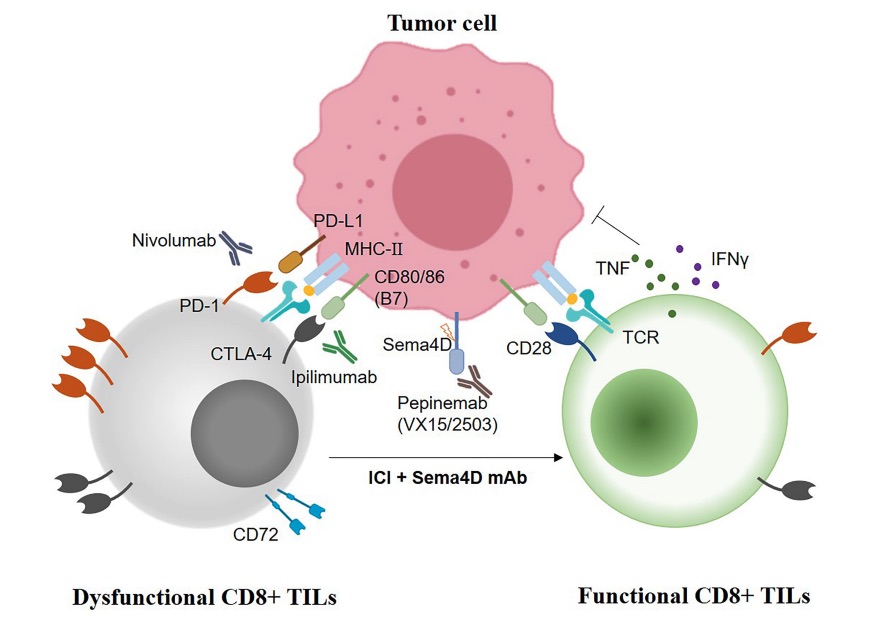Hi-Affi™ hPD-1/hSEMA4D Dual Humanized Mouse Model
In recent years, immune checkpoint inhibitor therapy shows significant progress in patients of different tumor types. However, some patients, especially those diagnosed with non-small cell lung cancer (NSCLC) are refractory to immune checkpoint inhibitors or have primary resistance. Preclinical studies suggested that targeting semaphorin 4D (SEMA4D) exhibited efficacy in anti-tumor treatment. The clinical combination of anti-SEMA4D and anti-PD-1 antibodies showed favorable anti-tumor activity and was well-tolerated. Creative Biolabs has successfully established an optimized Hi-Affi™ “humanized” animal platform to offer specialty manipulated hPD-1/hSEMA4D dual humanized mice for our clients all over the world.
hPD-1/hSEMA4D Molecule
T cells rely on proteins, such as human programmed cell death protein 1 (hPD-1) on the surface of cells to identify autologous and allogeneic cells. Under normal circumstances, T cells identify cancer cells so that the cancer cells automatically lyse to maintain the balance of the body.
Human SEMA4D (hSEMA4D, also called CD100) is one of the important members of the axon guidance protein IV subfamily (SEMAs IV). It has a wide distribution in non-lymphoid (heart, brain, kidney) and lymphoid tissues (spleen, thymus, and lymph nodes). In lymphoid organs, hSEMA4D is mainly expressed on the surface of resting T cells and has a lower expression level on resting B cells and antigen-presenting cells (APCs), such as dendritic cells (DCs). hSEMA4D is also distributed in other cells related to host defense capabilities, such as monocytes, neutrophils, endothelial cells, and epithelial cells. Recent studies reported high hSEMA4D expression on tumor-associated macrophages (TAMS) and a variety of solid tumor cells, including head and neck squamous cell carcinoma, breast cancer, prostate cancer, colon cancer, soft tissue sarcoma, and ovarian cancer. hSEMA4D usually regulates the movement and differentiation of certain cells, including cells from the immune system and vascular system.
 Fig. 1 The synergistic anti-tumoral strategies of combination Sema4D mAb with immune checkpoint inhibitors. 1
Fig. 1 The synergistic anti-tumoral strategies of combination Sema4D mAb with immune checkpoint inhibitors. 1
hPD-1/hSEMA4D Signal Pathway
Studies have confirmed that cancer cells thought of a "self-rescue" method: expressing human programmed cell death ligand -1 (hPD-L1) on the surface of cancer cells. hPD-L1 interacts with hPD-1 on the surface of T cells, causing T cells to "illusion" that cancer cells are "harmless". And thus, the immune activity is inhibited, and tumor cells complete self-rescue. hSEMA4D binds to plexin receptors located on myeloid cells in the tumor microenvironment. When the hSEMA4D protein is blocked, the hSEMA4D barrier can be eliminated. Once the barrier is breached, inflammatory DCs and pro-inflammatory APCs will migrate and penetrate the tumor. Blocking hSEMA4D with antibodies reverses the immune balance in the tumor microenvironment. The blockade of hSEMA4D will facilitate T cell infiltration in the tumor site, promotion of T cell activity, decrease of number of myeloid cells, and reduction in immunosuppression. These outcomes could overcome immune rejection and myeloid suppression. Clinical trials demonstrated that the anti-hSEMA4D antibody combined with immune checkpoint inhibitors, such as the anti-hPD-1 antibody, can enhance T cell infiltration and activation, and lead to lasting fading in NSCLC.
Development of hPD-1/hSEMA4D Dual Humanized Mice
In animal models of pre-clinical cancer, blocking SEMA4D with antibodies can delay tumor growth and promote durable rejection. Clinical utilization of anti-hSEMA4D antibody and other immune checkpoint inhibitors, such as the anti-hPD-1 antibody, might be a promising therapy compared to monotherapy of anti-hPD-1 antibody. With advanced technology, Creative Biolabs has assisted our global clients in their rug development with our well-established Hi-Affi™ “humanized” animal models. As a professional clinical CRO company, we can provide one-stop research services to advance your study implementation. Please let us know if you have any questions about our humanized mice or your study project.
Creative Biolabs also offers other various Humanized Mouse Models you may be interested in:
Reference
- Jiang, Jun, et al. "Semaphorins as potential immune therapeutic targets for cancer." Frontiers in Oncology 12 (2022): 793805. Distributed under Open Access license CC BY 4.0, without modification.
For Research Use Only.
